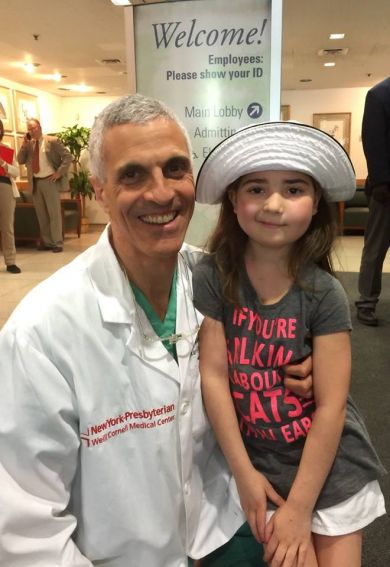Convection-enhanced delivery appears safe in pediatric diffuse intrinsic pontine glioma
Convection-enhanced delivery of a radio-labeled monoclonal antibody to the brain stem appeared safe among a small cohort of children with nonprogressive diffuse intrinsic pontine glioma, according to results of a phase 1 clinical trial.
Convection-enhanced delivery delivers an agent directly to the tumor site, bypassing the blood–brain barrier, which is usually an impediment to treating brain tumors.
The monoclonal antibody 124I-8H9 consists of the 8H9 antibody — which has shown efficacy in a range of tumors — and the radioactive substance 124I. Together 8H9 binds to the tumor and 124I kills cancer cells with radiation.
“This is the first systematic clinical trial in humans to utilize this form of local delivery in such a vital part of the central nervous system,” Mark M. Souweidane, M.D., pediatric neuro-oncologist at Weill Cornell Medicine, NewYork-Presbyterian and Memorial Sloan Kettering Cancer Center, told HemOnc Today. “It is revolutionary in the sense that it now takes what was purely based on concept and a lot of preclinical work into a clinical domain that opens up huge avenues of potential and capability with regard to other therapeutic strategies.”
Souweidane and colleagues began the phase 1 dose-escalation clinical study in 2012 with 25 children enrolled (mean age, 8 years; range, 3-17). Patients with nonprogressive diffuse intrinsic pontine glioma, or DIPG, underwent convection enhanced delivery 4 to 14 weeks after completion of radiation therapy.
Researchers evaluated a total of seven dose levels of a single injection of 124I-8H9 (range, 0.25-4 mCi, 250 to 4000 mcl).
“Our study was to basically prove the feasibility and safety of utilizing this very powerful strategy in the brain stem of children,” Souweidane said.
Patients tolerated up to 4 mCi of 124I-8H9. An infusion volume of 4,000 mcl appeared reasonable for a single dose of good tumor coverage.
Distribution volumes depended on dose and ranged from 1.5 cm3 to 20.1 cm3. The mean volume of distribution/volume of infusion was 3.4 (standard deviation, 1.2).
The mean lesion-absorbed dose was 1,527 rad/mCi. The mean tumor coverage on the level seven dose was 107%.
Adverse events remained limited to grade 1 or grade 2.
“An exciting thing is we have not reached a dose-limiting toxicity level yet, and no children have experienced a grade 4 or higher toxicity associated with this strategy,” Souweidane said.
The results clearly support safety of this technique, according to Souweidane, and dose escalations will continue to be studied.
“We are continuing our dose escalation with five more dose levels so the number of patients will double by the time we finish,” Souweidane said. “Paralleling that, we are also aligning a multi-institutional format through the Pediatric Brain Tumor Consortium to roll us out to a multicenter study from the standpoint of feasibility.”
This story originally appeared in HemOnc Today. Read the original here.



